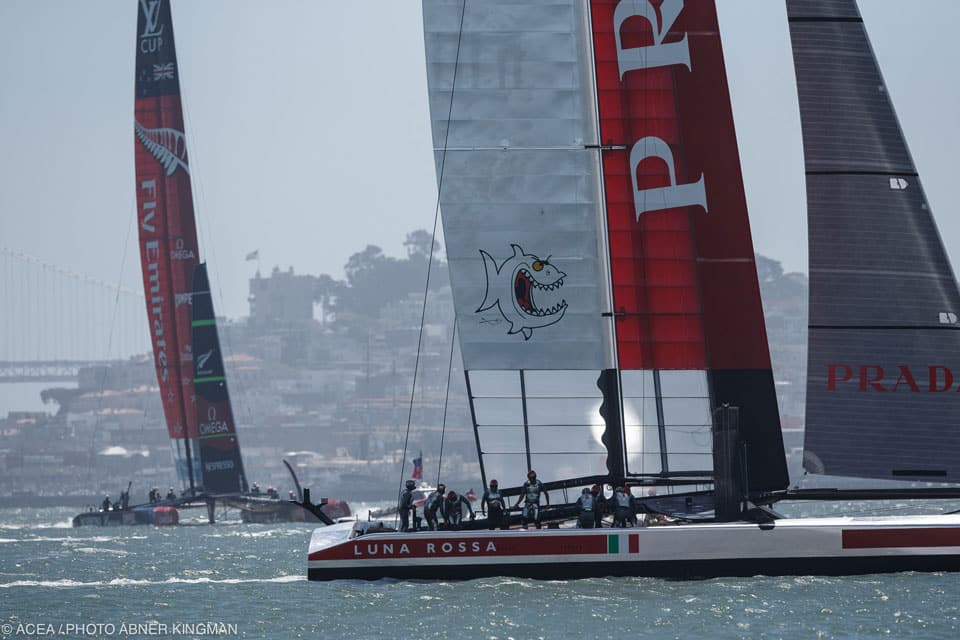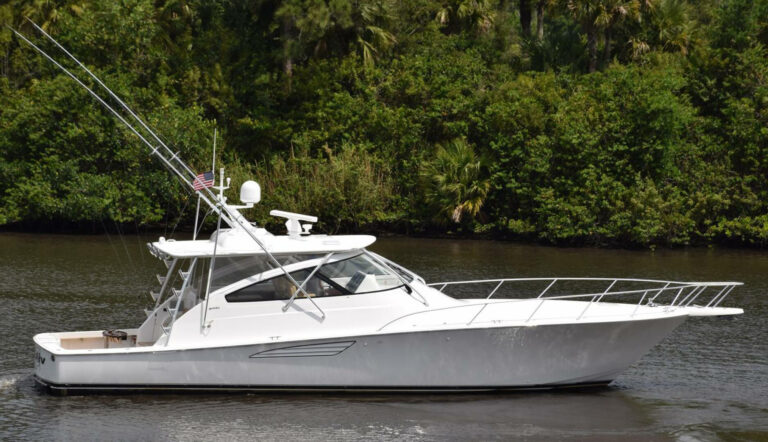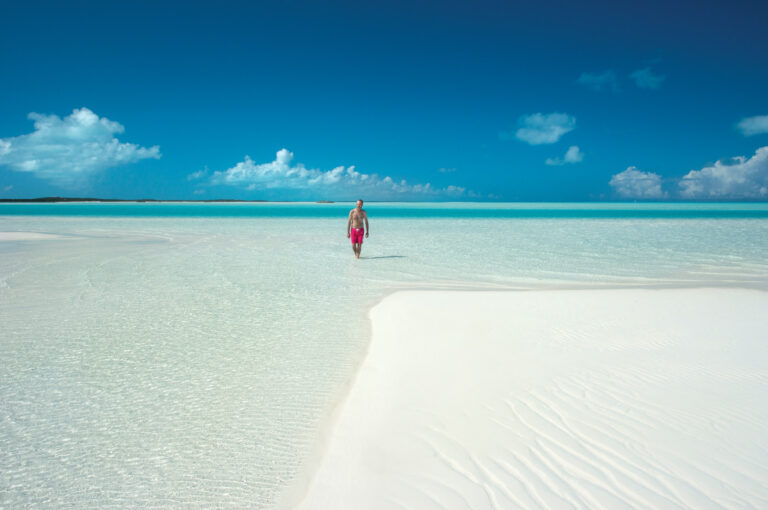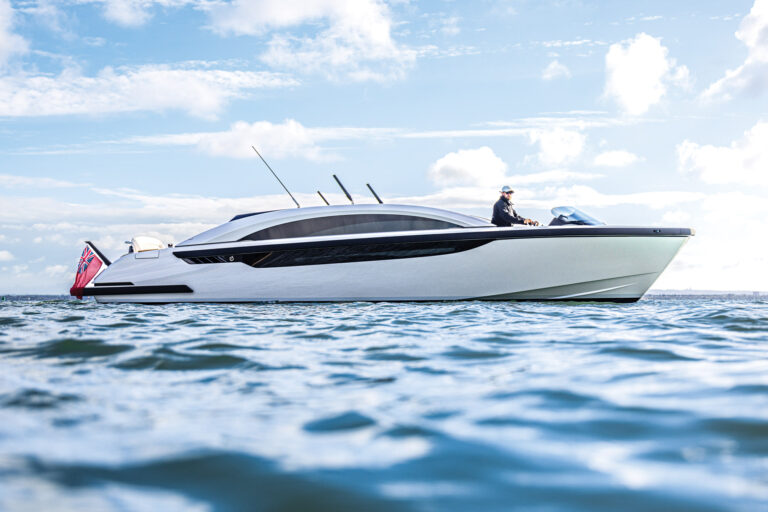
AC34 LVC
An amazing thing happened in the America’s Cup world this week: Boats have actually started racing, revealing some interesting performance and preparation information and yielding some gobsmacking images and video of the screaming-fast AC72-class catamarans tearing around on San Francisco Bay. While this is certainly a positive development, the waters are anything but ideal in this world of rarified racing.
As reported last week, two challengers, Emirates Team New Zealand (ETNZ) and Luna Rossa, both lodged protests against Iain Murray, Regatta Director and CEO of America’s Cup Race Management, for inadvertently changing the AC72 class rule via a list of 37 Safety Recommendations, rather than following official Protocol. Italian-flagged Luna Rossa refused to race until the International Jury handed down their decision on the protests. As a result, ETNZ enjoyed some “soliloquy sailing”, running uncontested laps around the racecourse and amassing an early advantage on the leaderboard. Fortunately, the International Jury delivered their decision late last week, upholding ETNZ and Luna Rossa’s protest and clearing the way for the Italians to actually line up on the racecourse.
Saturday, July 13 delivered perfect sailing conditions (ballpark 20 knots of breeze) on San Francisco Bay for the historic first racecourse encounter between two wingsail-powered, foil-borne AC72 class catamarans. Dean Barker, skipper of ETNZ, earned the upper hand over Chris Draper, Luna Rossa’s helmsman, in the prestart maneuvers. According to reports, Barker and his ETNZ crew scorched across the starting line at over 40 knots, beating Luna Rossa for the start. By the time the two boats reached the first mark ETNZ had earned a five-second advantage, which they constantly extended throughout the race. ETNZ quietly pushed this delta to a more-than-healthy (read: lopsided) five minutes and twenty-three seconds by the end of the race, drawing the first real blood in this Louis Vuitton Cup (LVC).
While this first victory was a well-earned landslide, the Kiwis are careful not to gloat. “It was a good encounter,” said ETNZ boss, Grant Dalton. “We are further ahead on the development curve [than the Italians]. Luna Rossa’s target has always been to peak in the Louis Vuitton Cup finals. We will have to keep on getting better.”
Dalton’s words certainly echo the sentiments of great sportsmanship, but the bottom-line truth is that it will be hard—if not impossible—for Luna Rossa to close the gaping performance delta between their program and that of their Kiwi friends. As some readers may recall, Luna Rossa was a latecomer to this Cup. To help advance their position on the AC72 design curve, the Italians and the New Zealanders entered into an agreement to share the base package design for a first-generation AC72. As a result, both teams built slippery and easy-to-foil (relatively speaking) hull platforms and wingsails that were essentially identical, minus the foil package and other proprietary details. This shared design allowed the two teams to engage in mock races and two-boat testing on the waters of New Zealand’s Hauraki Gulf last winter, giving both teams vast amounts of valuable empirical data. Luna Rossa used this information to refine and modify their boat, while ETNZ used their acquired knowledge to build an even faster second-generation AC72.
Flash-forward to Saturday’s race, and it’s now dead obvious that ETNZ’s second-generation boat is much faster than the Italians’, now-modified first-generation boat. Moreover, ETNZ is clearly the more polished team, executing absolutely spot-on foiling gybes (the hardest maneuver to perform on an AC72) and demonstrating superior boathandling skills. “Luna Rossa has stepped it up on the downwind stuff,” said Barker. “They probably have some work to do on the upwind stuff, but it’s early days for them and their new systems and setup. They’ll get better for sure.”
While this is certainly cause for celebration in the Kiwi camp, this landslide victory could prove detrimental to the LVC as it’s apparent that this challenger’s cup is ETNZ’s to loose. Artemis Racing—the Challenger of Record for the 34th America’s Cup—still isn’t race-ready, and Luna Rossa clearly isn’t yet up to pace. While the Italians will certainly hone and improve their game throughout the summer, ETNZ is clearly also in the refinement business.
For fans, race promoters and sponsors, this performance delta threatens to foreshadow a rather boring and predictable LVC outcome. There’s virtually no chance that Artemis will be able to win the LVC, given that they have not yet even sailed their second-generation AC72 and it is highly unlikely that Luna Rossa’s modified first-generation boat will prove competitive against ETNZ’s newest design. This could also hold huge ramifications for AC34 (September 7-21), as ETNZ isn’t likely to receive much “battle hardening” over the next month and a half of LVC racing.
A glance at the next week’s racing schedule reveals more unopposed racing for both ETNZ and Luna Rossa due to Artemis Racing’s prolonged absence, as well as two more two-boat races (Saturday and next Tuesday). These races will be Luna Rossa’s next opportunities to show the world that they have the ability to improve their program in real time. Otherwise, the age-old Cup cliché, “Madam, there is no second” will take on an entirely new meaning in a Cup cycle that has seen this line trotted around far more frequently than any sailor, spectator or sponsor would like.
So, while the legal mayhem surrounding ETNZ and Luna Rossa’s protest has been quieted (for now), and boats are actually engaged in high-speed match racing, this summer’s LVC still has a long, long way to go before it hits the high notes that were promised when the Defender, Oracle Racing Team USA, unveiled their plans for this year’s “Summer of Racing”. Stay tuned, as this ride will likely get a lot stranger before the September 7 guns sound for the 34th America’s Cup.








